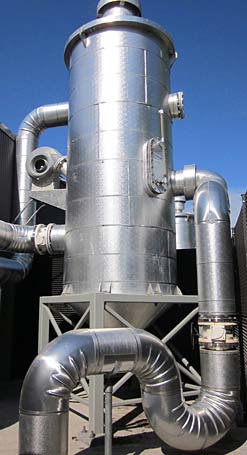forum
library
tutorial
contact

Hatchery Fish Released Early to Avoid
High Gas Levels from Dworshak Dam
by Laura Berg
NW Fishletter, April 3, 2017
|
the film forum library tutorial contact |

|
Hatchery Fish Released Early to Avoid
by Laura Berg
|
 Dworshak and Clearwater hatcheries in the Snake River Basin reluctantly released juvenile Chinook and steelhead starting March 20, several weeks earlier than normal.
Dworshak and Clearwater hatcheries in the Snake River Basin reluctantly released juvenile Chinook and steelhead starting March 20, several weeks earlier than normal.
The decision was forced by a combination of high runoff and a major turbine repair resulting in large volumes of water being spilled at Dworshak Dam during February and early March.
Water roaring over the spillway causes high levels of dissolved gas that can injure or even kill juvenile salmonids.
At one of many March meetings of the Technical Management Team (TMT), the U.S. Army Corps of Engineers announced it needed to reverse course and hold back more water at Dworshak Dam to prevent local flooding and flooding farther downstream.
The Corps reduced outflows from 23,500 cfs to 7,500 cfs over three days, March 17-20.
The hiatus in high flows and high total dissolved gas (TDG) provided a window for hatchery managers to release juvenile Chinook and steelhead into the Clearwater River, a tributary of the Snake River.
Hatchery representatives attending TMT meetings over the previous week said the Chinook and, particularly, the steelhead juveniles were not mature enough for release into the river.
Yet if hatchery managers waited until they were sufficiently mature, high flows and spill--and the accompanying high TDG levels--would be back. Steve Hall, the Corps' Walla Walla District reservoir manager, told TMT members that within several days flows would reach 25,000 cfs and would likely remain high through April.
Normally, more flow would be coursing through hydroelectric turbines, including through Unit 3, the largest of three generating turbines at Dworshak Dam. But Unit 3 has been off line for repair since September.
The Corps is letting water go at high rates to make room in the reservoir behind Dworshak for a spring runoff that is expected to be 118 percent of average this year.
Dworshak National Fish Hatchery Complex, jointly operated by the U.S. Fish and Wildlife Service and Nez Perce Tribe, released some 1 million juvenile Chinook into the Clearwater River March 20. Releases were also made at the Clearwater Fish Hatchery, an Idaho Department of Fish and Game facility.
About half of the juvenile steelhead from Dworshak hatchery were released early on March 21, with the rest of the steelhead smolts planned for release in mid-April.
The high spill-induced levels of TDG in the river also produce high levels of gas in downstream hatchery facilities. Degassing equipment at Dworshak hatchery kept TDG levels at about 105 percent compared to 120 percent TDG and more in the river.
Over the past 10 days, as spill and TDG levels rose, hatchery representatives told TMT members that juvenile fish were showing signs of gas-bubble trauma.
The Clearwater hatchery has less of a TDG problem because it doesn't draw water from the same Clearwater River source as the Dworshak hatchery. In fact, the Clearwater hatchery will truck some of its nearly gas-free water to the Dworshak facility to improve conditions for the juvenile steelhead that will be released in mid-April.
In addition to spill and a high TDG problem at Dworshak dam--a one-off issue triggered by the Unit 3 outage--dam and fish managers have been going round and round at TMT about the appropriate level and timing of holding water back versus letting it go.
While acknowledging flood control trumps the needs of both fish and power generation, some fish managers have questioned the need to maintain high outflows to empty the Dworshak reservoir now.
The dam operators, the Corps and BPA, have said waiting to bring down reservoir levels risks not having enough space for spring runoff--an impermissible risk under federal flood-control rules.
On the bright side, this year's high flows could help juvenile Chinook, steelhead and other salmonids make a speedy downstream journey to saltwater. Generally, the quicker fish get to the ocean the better their chance of survival.
learn more on topics covered in the film
see the video
read the script
learn the songs
discussion forum
